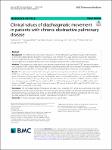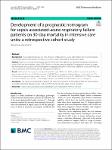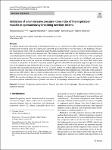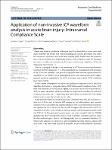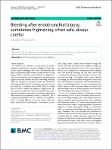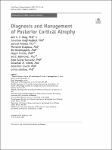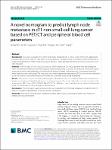Search
Author
- Osman, Ahmed I. (5)
- Daqing, Ma (3)
- Jorgensen, Ed (3)
- Li, Yan (3)
- next >
Subject
- kinh tế (26)
- Economics (12)
- programming (10)
- XRD (10)
- next >
Date issued
- 2020 - 2025 (2129)
- 2010 - 2019 (129)
- 2000 - 2009 (9)
- 1999 - 1999 (1)
Has File(s)
Search Results
Exercise intolerance is among the most common symptoms experienced by patients with chronic obstructive pulmonary disease (COPD), which is associated with lung dynamic hyperinflation (DH). There was evidence that positive expiratory pressure (PEP), which could be offered by less costly devices, could reduce DH. The purpose of this study was to evaluate the efficacy and safety of long-term domiciliary use of PEP device in subjects with COPD. |
The limitation of activity due to dyspnea in chronic obstructive pulmonary disease (COPD) patients is affected by diaphragmatic dysfunction and reduced lung function. This study aimed to analyze the association between diaphragm function variables and forced expiratory volume in the first second (FEV1) and to estimate the clinical significance of diaphragm function in the correlation between COPD severity and lung function. |
To evaluate if the increase in chloride intake during a continuous infusion of 20% hypertonic saline solution (HSS) is associated with an increase in the incidence of acute kidney injury (AKI) compared to standard of care in traumatic brain injury patients. |
Acute respiratory failure is a type of sepsis complicated by severe organ failure. We have developed a new nomogram for predicting the 30-day risk of death in patients through a retrospective study. |
To validate the pressure–time index of the inspiratory muscles as a non-invasive index of inspiratory muscle function in spontaneously breathing infants by comparing it against the gold-standard pressure–time index of the diaphragm. Prospective observational cohort study of consecutive infants breathing unsupported in room air in a tertiary neonatal intensive care unit, studied prior to discharge from neonatal care. |
Various non-invasive monitoring techniques have been developed in recent years seeking to minimize the burden that repeated imaging and invasive procedures may inflict on the journey of patients with acute brain injuries (ABI). Furthermore, the combination of these methods may theoretically enhance their predictive value for functional outcomes, as well as the detection of alterations in intracranial compliance (ICC) and intracranial hypertension [1]. |
However, it should be noted that endobronchial biopsy (EBB), which is the biopsy method used in our study [2], is different from TBLB. TBLB is usually used to collect samples of peripheral lung lesions, diffuse lesions, or infiltrative lesions around the lung, meaning that the lesions commonly receive blood supply from both bronchial and pulmonary artery. In addition, TBLB is generally performed with or without X-ray guidance, and it is usually difficult to see the lesions under the direct view of the bronchoscope. Nevertheless, in our study, lung cancer samples were collected using EBB. On the one hand, the main blood supplies to lung cancer come from the bronchial arteries [3, 4], thus, the pulmonary artery pressure has anatomically little influence with EBB-induced bleeding. |
The study aims to provide a summary of recent developments for diagnosing and managing posterior cortical atrophy (PCA). We present current efforts to improve PCA characterisation and recommendations regarding use of clinical, neuropsychological and biomarker methods in PCA diagnosis and management and highlight current knowledge gaps. |
sCD59, as a soluble form of CD59, is observed in multiple types of body fluids and correlated with the cell damage after ischemia/reperfusion injury. This study aims to observe the dynamic changes of serum sCD59 in patients after restoration of spontaneous circulation (ROSC) and explore the association of serum sCD59 with neurological prognosis and all-cause mortality in patients after ROSC. |
Accurately evaluating the lymph node status preoperatively is critical in determining the appropriate treatment plan for non-small-cell lung cancer (NSCLC) patients. This study aimed to construct a novel nomogram to predict the probability of lymph node metastasis in clinical T1 stage patients based on non-invasive and easily accessible indicators. |


